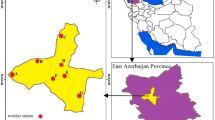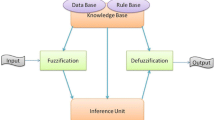Abstract
Increasing industrial developments increased the environmental pollution problems in many cities of the world. Air quality modelling and indexes are used to introduce the information on local air quality indicators in polluted regions. Estimation and monitoring of air quality in the city centres are important due to environmental health and comfort of human-related topics. Air quality approximation is a complicate subject that artificial intelligent techniques are successfully used for modelling the complicated and nonlinear approximation problems. In present study, artificial neural network and an adaptive neuro-fuzzy logic method developed to approximate the impact of certain environmental conditions on air quality and sulphur dioxide pollution level and used with this study in Konya city centre. Data of sulphur dioxide concentrations were collected from 15 selected points of Konya city for prediction of air quality. Using air quality standards, air quality was discussed by considering the sulphur dioxide concentration as independent variables with meteorological parameters. Different meteorological parameters were used for investigation of pollution relation. One of the important modelling tools, adaptive network-based fuzzy inference system model, was used to assess performance by a number of checking data collected from different sampling stations in Konya. The outcomes of adaptive network-based fuzzy inference system model was evaluated by fuzzy quality charts and compared to the results obtained from Turkey and Environmental Protection Agency air quality standards. From the present results, fuzzy rule-based adaptive network-based fuzzy inference system model is a valuable tool prediction and assessment of air quality and tends to propagate accurate results.








Similar content being viewed by others
References
Alkasassbeh M, Sheta AF, Faris H, Turabieh H (2013) Prediction of PM10 and TSP air pollution parameters using artificial neural network autoregressive, external input models: a case study in salt, Jordan. Middle East J Sci Res 14:999–1009
Aw J, Kleeman M (2003) Evaluating the first-order effect of intra annual temperature variability on urban air pollution. J Geophys Res 108(D12):5047–5068
Barnett AG, Williams GM, Schwartz J, Best TL, Neller AH, Petroeschevsky AL (2006) The effects of air pollution on hospitalizations for cardiovascular disease in elderly people in Australian and New Zealand cities. Environ Health Perspect 114:1018–1023
Bertoni G, Tappa R, ve Allegrini I (2000) Assessment of a new device for the monitoring of benzene and other volatile aromatic compounds in the atmosphere. Annali di Chim 90:249–263
Cacciola M, Pellicanò D, Megali G, Lay-Ekuakille A, Versaci M, Morabito FC (2013) Aspects about air pollution prediction on urban environment. 4th Imeko TC19 symposium on environmental instrumentation and measurements protecting environment, climate changes and pollution control, June 3–4, 2013, Lecce, Italy, pp 15–20
Chelani AB, Rao CVC, Phadke KM, Hasan MZ (2002) Prediction of sulphur dioxide concentration using artificial neural networks. Environ Model Softw 17:161–168
Curtis L, Rea W, Smith-Willis P, Fenyves E, Pan Y (2006) Adverse health effects of outdoor air pollutants. Environ Int 32:815–830
Deutsch A, de la Parra RB, de Boer RJ (eds) (2008) Mathematical modeling of biological systems, volume II: epidemiology, evolution and ecology, immunology, neural systems and the brain, and innovative mathematical methods. Springer, Birkauser, pp 406
Dursun S (1997) Effects of topographical structure around Samsun city on air pollution in the region, 20th geology symposium, Konya, pp 211–215
Dursun S, Ucan HN (2009) Air pollution dimensions of Konya City and environmental effects 15th international symposium on environmental pollution and its impact on life in the mediterranean region October 7–11, Bari, Italy
Dursun S, Onder S, Acar R, Direk M, Mucehver M (2012) Effect of environmental and socioeconomically change on agricultural production in Konya region 2012 international conference on applied life sciences (ICALS), Turkey, 10–12 September 2012, pp 1–11
Fallahpour AR, Moghassem AR (2013) Yarn strength modelling using adaptive neuro-fuzzy inference system (ANFIS) and gene expression programming (GEP). J Eng Fibers Fabr 8:6–18
Fuller AD (1995) Neural fuzzy systems. Abo Akademi University, Abo
Gardner MW, Dorling SR (2000) Statistical surface ozone models: an improved methodology to account for nonlinear behavior. Atmos Environ 34:21–34
Goyal SK, Ghatge SV, Nema P, Tamhane SM (2006) Understanding urban vehicular pollution problem vis-a-vis ambient air quality- case study of a megacity (Delhi, India). Environ Monit Assess 119:557–569
Güçlü G, Dursun S (2010) Hybrid modelling approach for improving prediction performance of a mathematical model in a large-scale wastewater treatment plant. Bioprocess Biosyst Eng 33:1051–1058
Hájek P, Olej V (2009) Intuitionistic Hierarchical Fuzzy Inference Systems Design for Air Quality Modelling. In: Mastorakis N et al (eds) Proceedings of the 5th International Conference on Energy, Environment, Ecosystems and Sustainable Development, (EEESD’09), Greece, pp 89–94
Jang JSR, Sun CT, Mizutani E (1997a) Neuro-fuzzy and soft computing: a computational approach to learning and machine intelligence. Prentice Hall, NJ, p 587
Jang JSR, Sun CT, Mizutani E (1997b) Neuro-fuzzy and soft computing. Prentice Hall, NJ, p 1081
Jorquera H, Perez R, Cipriano A, Espejo A, Letelier MV, Acuna G (1998) Forecasting ozone daily maximum levels at Santiago, Chile. Atmos Environ 32:3415–3424
Kadiyala A, Kumar A (2012) Guidelines for operational evaluation of air quality models. Lambert Academic Publishing GmbH & Co, Germany, p 123. ISBN 978-3-8465-3277-5
Kadiyala A, Kumar A (2013) Artificial intelligence: emerging approaches for environmental data analysis, EM, 4- 5, Aug. (invited paper)
Kadiyala A, Kaur D, Kumar A (2013) Development of hybrid genetic algorithm based neural networks using regression trees for modeling air quality inside a public transportation bus. J Air Waste Manag Assoc 63:205–218
Khan FI, Sadiq R (2005) Risk-based prioritization of air pollution monitoring using fuzzy synthetic evaluation technique. Environ Monit Assess 105:261–283
Khare M, Nagendra SM (2007) Vehicular pollution, artificial neural networks in vehicular pollution modelling. SCI 41:7–24
Kunt F, Dursun Ş (2010) The effect of some meteorological factors to the air pollution in center of Konya. In: International Conference on Air Pollution and Control, Ankara 25–27 October
Kunt F, Dursun S (2012) Measurement of atmospheric ozone concentration using passive sampler method in Konya city centre during 2012 winter period. International conference on “Towards future sustainable development” Shkodër, Albania 16–17 November 2012 Abstract Book, p 192
Lin CT (1996) Neural fuzzy systems: a neuro-fuzzy synergism to intelligent, Prentice Hall PTR, New Jersey, p 797
Moumeni B, Golmai SH, Palangi JA (2013) Comparison of using different systems of artificial intelligence in subsurface water level prediction (case study: paddy fields of plain areas between Tajan and Nekaroud Rivers, Mazandaran, Iran). J Novel Appl Sci 2:375–381
Nie J (1995) Constructing fuzzy model by self-organizing counterpropagation network. IEEE Trans Syst Man Cybern 25(6):963–970
Onkal-Engin G, Demir I, Hiz H (2004) Assessment of urban air quality in Istanbul using fuzzy synthetic evaluation. Atmos Environ 38:3809–3815
Ordieres JB, Vergara EP, Capuz RS, Salazar RE (2005) Neural network prediction model for fine particulate matter (PM2.5) on the US–Mexico border in El Paso (Texas) and Ciudad Jua ´rez (Chihuahua). Environ Model Softw 20:547–559
Ozden O (2005) Master of Science thesis: monitoring of air quality by use of passive samplers. Anadolu University, Graduate School of Natural and Applied Sciences, Environmental Engineering Program, Eskişehir, Turkey
Öztürk AI, Arslan M, Toros H, Dursun S (2013) Air quality forecast study in Istanbul. 13th EMS annual meeting & 11th European Conference European Meteorological Society, Reading Un. UK
Perez P, Trier A (2001) Prediction of NO and NO2 concentrations near a street with heavy traffic in Santiago, Chile. Atmos Environ 35:1783–1789
Perez P, Trier A, Reyes J (2000) Prediction of PM2.5 concentrations several hours in advance using neural networks in Santiago, Chile. Atmos Environ 34:1189–1196
Rani BK, Govardhan A (2013) Rainfall prediction using data mining techniques—a survey. Comput Sci Inf Technol 3:23–30
Rawat K, Burse K (2013) A soft computing genetic-neuro fuzzy approach for data mining and its application to medical diagnosis. Int J Eng Adv Technol 3:409–411
Romieu I, Lugo MC, Velasco SR, Sanchez S, Meneses F, Hermandez M (1992) Air pollution and school absenteeism among young children in Mexico City. Am J Epidemiol 136:1424–1531
Savić M, Mihajlović I, Živković Ž (2013) An Anfis—based air quality model for prediction of SO2 concentration in urban area. Serb J Manag 8:25–38
Soni A, Shukla S (2012) Application of neuro-fuzzy in prediction of air pollution in urban areas. IOSR J Eng 2:1182–1187
Sowlat MH, Gharibi H, Yunesian M, Mahmoudi MT, Lotfi S (2011) A novel, fuzzy-based air quality index (FAQI) for air quality assessment. Atmos Environ 45:2050–2059
Sugeno M, Takagi T (1983) Multi-dimensional fuzzy reasoning. Fuzzy Sets Syst 9(2):313–325
Taylan O (2013a) Prediction of air quality for sustainable environment by artificial intelligent techniques. Energy Educ Sci Technol Part A Energy Sci Res 31:1635–1652
Taylan O (2013b) Assessing air quality in Jeddah by modeling suspended PM10 concentration. J Int Environ Appl Sci 8:326–335
Taylan O, Taskin H (2003) Fuzzy modeling of a production system. J Nav Sci Eng 1:1–13
Yay OD, Özden Ö, Altuğ H, Gaga E, Erdemir G, Örnektekin S, Döğeroğlu T, Melıefste K, Doorn WV (2008) Preliminary assessment of air quality in İskenderun-Payas Strict with passive sampling. International Conference of Air Pollution and Control-2008, 22–25 Ekim, Hatay
Yetilmezsoya K, Fingas M, Fieldhouse B (2011) An adaptive neuro-fuzzy approach for modeling of water-in-oil emulsion formation. Colloids Surf A Physicochem Eng Aspects 389:50–62
Yıldırım Y, Bayramoglu M (2006) Adaptive neuro-fuzzy based modelling for prediction of air pollution daily levels in city of Zonguldak. Chemosphere 63:1575–1582
Zemp E, Elsasser S, Schindler C, Kunzli N, Perruchoud A, Domenighetti G (1999) Long-term ambient air pollution and respiratory symptoms in adults (SAPALDIA study). Am J Respir Crit Care Med 159:1257–1266
Zounemat-Kermani M, Scholz M (2013) Computing air demand using the Takagi–Sugeno model for dam outlets. Water 5:1441–1456
Acknowledgments
Authors would like to thank Selcuk University (BAP) for the financial support of this study with Project Number BAP-10401028.
Author information
Authors and Affiliations
Corresponding author
Rights and permissions
About this article
Cite this article
Dursun, S., Kunt, F. & Taylan, O. Modelling sulphur dioxide levels of Konya city using artificial intelligent related to ozone, nitrogen dioxide and meteorological factors. Int. J. Environ. Sci. Technol. 12, 3915–3928 (2015). https://doi.org/10.1007/s13762-015-0821-2
Received:
Revised:
Accepted:
Published:
Issue Date:
DOI: https://doi.org/10.1007/s13762-015-0821-2




